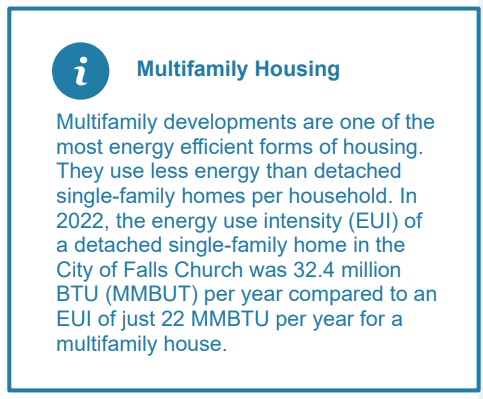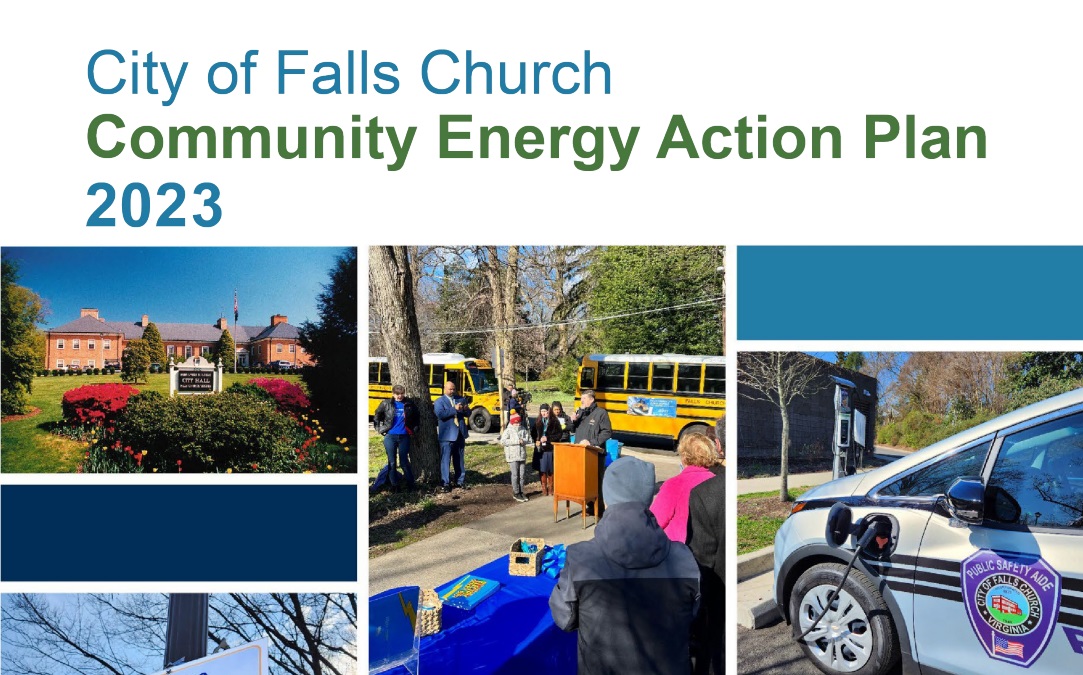Energy Plan Includes Residential Zoning Changes For Greater Density
A Community Energy Plan that includes zoning changes
On November 13, 2023, the City Council adopted by a 4-2 vote the Community Energy Action Plan (CEAP), which complements the Government Operations Energy Action Plan adopted earlier this year. The Council hailed many aspects of the proposal, which seeks to support residents and local businesses in drastically reducing greenhouse gas emissions.
Yet Council members sparred over whether the plan should include language regarding specific zoning changes the City could undertake to promote greater density in residential neighborhoods—language that was added only in September, was not the subject of community information sessions and town halls, and enshrines specific proposals in an endorsed plan.
Purpose of the CEAP
The energy plan’s overarching goals, unanimously backed by the City Council, are to pursue strategies and actions that will cut the City’s greenhouse gas emissions in half by 2030 and achieve net zero emissions by 2050. The CEAP seeks to identify ways the City can promote a reduction in emissions among residents and businesses, given that only 3% of these emissions are produced by the City government in its operations, and the majority of greenhouse gas emissions are transportation and building related.
The focus of the plan is educating the public on and executing the following strategies to achieve the City’s ambitious climate goals:
- Enhance Access to Car-Free Alternatives
- Accelerate the Shift to Electric Vehicles (EVs)
- Improve Efficiency and Electrify Our Buildings
- Minimize Carbon Impacts of New Development
- Increase Adoption of Rooftop Solar
- Improve Measuring, Tracking, and Reporting of Activity and Emissions, and Promote Progress Within the Community
Zoning changes proposed in the CEAP
Yet, in the last two months, additional language about zoning changes to residential properties was embedded in the energy plan. While the City Council has yet to propose, evaluate, or enact any of the zoning changes identified to “Minimize Carbon Impacts of New Development,” approval of the CEAP effectively sets in motion clear plans to pursue them.
Plan guides future Council legislative priorities
Citizens can expect that the City Council will invoke the CEAP’s climate goals—including the goals related to greater density in residential neighborhoods—when setting Council priorities. Further, the plan likely will be incorporated into the City’s Comprehensive Plan as having community support. This is so even though the public was and remains generally unaware of such consequential steps for residential zones and would not think to look for such information in a plan primarily about incentivizing EVs, solar roofs, and heat pumps.
That it is the Council majority’s intent to pursue these changes is all the more apparent given the lack of any willingness to compromise on revising the zoning language to be more general, as Mayor P. David Tarter and Council Member David Snyder sought in an amendment to the CEAP before the vote to approve the energy plan.
Proposed zoning changes
The zoning changes that the CEAP asserts “can reduce the need for car travel and make walking, biking, and public transit a more viable solution to everyday errands and commuting” are “hiding in this document where [they don’t] belong,” Mark Gross, president of the Village Preservation & Improvement Society (VPIS), said during the Council meeting.

The specific zoning suggestions contained in section 4.2 of the plan, which has been part of the CEAP since September 13, 2023, but has not been highlighted or discussed at any public presentations of the plan, include:
- enabling accessory dwelling use,
- allowing multiple units per lot,
- reducing minimum residential lot sizes for residential districts R1A and R1B,
- allowing an administrative variance process for minor additions to and expansions of existing non-conforming homes, and
- reducing parking requirements.
Greater housing density, higher emissions
Mayor Tarter and Mr. Snyder reluctantly opposed the energy plan because, contrary to the CEAP’s goal of making Falls Church carbon neutral in the next 27 years, more density will increase greenhouse gas emissions. Andy Young, coordinator of the City’s Environmental Sustainability Programs and principal author of the energy plan, agreed that this result is true at a VPIS presentation the day before the Council meeting and during the discussion of the CEAP in response to a question from Mr. Snyder.
Further, the referenced zoning changes affect residential rather than commercial districts, and the public is unaware of and has yet to discuss this significant policy shift, Mayor Tarter said. He proposed an amendment to the plan, which Mr. Snyder then moved and Mr. Tarter seconded, that called for unspecified zoning changes to be “considered” rather than “enacted.” Such language would allow the Council to consider future zoning changes, including on residential lots, and further development on larger thoroughfares and transit corridors without endorsing specific changes to residential districts, as the plan currently does for R1A and R1B zones. However, their efforts failed, 2-4.
Failure to truly protect the environment
While he praised Mr. Young’s work, Mr. Snyder said the CEAP could be improved by focusing more on the regional Bus Rapid Transit project for Route 7, asking more from our State Senator and Delegate in the way of climate funding and standards, and placing a greater emphasis on the value of the City’s mature trees and tree canopy.
“I would not object to the inclusion of section 4.2 if I thought we had a history of truly protecting the environment as we achieve greater density. Regrettably, we do not,” Mr. Snyder added in a reference to the recent debate over changes to transition, or T, zoning. He expressed a desire to have section 4.2 removed from the plan.
No community discussion of greater density in neighborhoods
Mayor Tarter said that when he ran for City Council 12 years ago, he wanted to see more development on commercial streets, and “we have gotten it. Housing units will increase 25% in the next two years, according to City staff.”
Such density, however, belongs along the City’s major thoroughfares, Tarter argued, yet “all the [zoning] suggestions in the plan are about density in established neighborhoods.” He added that the CEAP “has not been widely disseminated or fully discussed” by citizens.
Will the CEAP kick off new zoning code revisions?
Council Member Marybeth Connelly said that by approving the plan, “we aren’t actually saying we are doing all of this.” Vice Mayor Letty Hardi added that the plan “doesn’t endorse any specific changes; obviously further community conversations are needed.”
Nonetheless, Vice Mayor Hardi asserted without attribution that “per capita emissions actually drops with density….It’s important to talk about facts when it comes to climate change, and land use is very much a part of that,” she added. That statement conflicted with Mr. Young’s earlier concessions that greater density can increase local emissions in the City, although it has the opportunity to reduce emissions regionally.
Community consensus needed on climate action
Prior to the City Council’s votes on the amendment to and approval of the CEAP, Joseph Schiarizzi, chair of the Environmental Sustainability Council but speaking for himself alone, stepped to the microphone to support acceptance of the Tarter-Snyder amendment.
“This is a community energy action plan, and having the community bought into it is smart and worth doing,” Mr. Schiarizzi said. He asked the City Council majority to “make this less contentious and more about working together to solve a global threat…Even with [section] 4.2 taken out completely, this is still a great plan.”
Despite Mr. Schiarizzi’s signal of support for the amendment, a Council majority quickly shut down any compromise with a 4-2 vote to reject the amendment, thereby retaining the language highly specific to R1A and R1B zones in the energy plan.
Joseph Schiarizzi speaks to City Council (1m 12s):
Zoning section slid into the CEAP, offers misleading data
In his public comments, Mr. Gross said the zoning changes in section 4.2 appeared to have been “slid into [the plan]…without any notice to the public that something as important as this is in a document where you wouldn’t expect to see it.”
Mark Gross speaks to City Council (4m 3s):
The CEAP includes only one unattributed data point and establishes no measurable impacts of such zoning changes on the City’s greenhouse gas emissions.
An information box in the plan (shown below) notes that: “Multifamily developments are one of the most energy efficient forms of housing.” The data on which this statement is based appear to be extrapolated from general Metropolitan Washington Council of Governments (MWCOG) figures, but their source is not clear, and the size of the “multifamily house” is not specified.

What the adopted energy plan does do is provide an unsubstantiated rationale for the listed zoning changes that the City Council may legislate in the future.
Additional proposed new development actions
The CEAP’s Strategy 4, entitled “Minimize Carbon Impacts of New Development” (see pages 25-28 of the 47-page final plan document), also calls for steps that seem more in keeping with the rest of the plan than the zoning changes. These actions would revise the City’s Special Exception criteria with more specific expectations about energy use intensity and electrification, and consider the City’s adoption of the most rigorous U.S. Green Buildings Council Leadership in Energy and Environmental Design (LEED) Platinum certification for new construction.
Additional actions include reinvigorating the City’s Green Home program with more ambitious requirements and corresponding incentives, and advocating for a more energy-efficient state building code and local authority to go beyond what Virginia’s law demands.
No measurable milestones
The energy action plan’s authors acknowledge that, in contrast to the other key strategies outlined in the CEAP, they could not quantify direct emissions reduction impacts for any of the actions that comprise the new development strategy.
For example, while the plan sets as a milestone for car-free alternatives that passenger car vehicle miles traveled will be reduced 20% by 2030, CEAP notes that “specific reductions for new buildings (Strategy 4) were not modeled.” The most that the plan can say for this strategy is that it will “encourage energy efficient and low-carbon development in the City.”
References:
The video of the complete City Council meeting can be found here. Council discussion of the CEAP takes place between 1:10:10 and 1:39:32. Mr. Gross’s comments can be found in the video from 43:50 to 47:53, and Mr. Schiarizzi’s remarks are found at 1:37:32-1:38:39.
- City of Falls Church Community Energy Action Plan: https://fallschurch-va.granicus.com/MetaViewer.php?view_id=2&event_id=1370&meta_id=127004
- (TR23-30) Resolution To Adopt The Community Energy Action Plan for the City of Falls Church: https://fallschurch-va.granicus.com/MetaViewer.php?view_id=2&event_id=1370&meta_id=127002
- City Council Meeting, November 13, 2023, https://www.youtube.com/watch?v=Oke1P0bmChY&ab_channel=CityofFallsChurchGovernment

